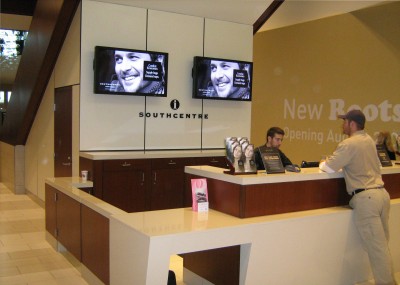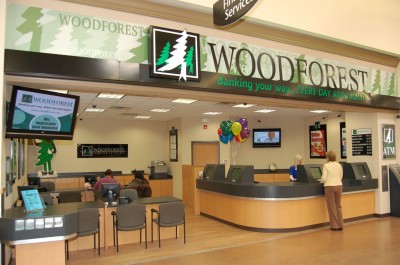Networks in the cloud
by Matthew | 13 May 2012 11:39 am
 [1]
[1]Photos courtesy Omnivex
By Doug Bannister
When planning a digital signage deployment, today’s system planners are faced with the increasingly difficult decision of whether or not to host the network on-site. With the growing trend of moving data to the ‘cloud,’ the concept of Software as a Service (SaaS) has been gaining traction as a basis for digital signage platforms. It is also important, however, to consider the nature of the client’s business and the degree of control necessary for that business’ data.
By understanding the fundamentals of both cloud computing and on-premise hosting models, digital signage system providers can determine which is a better fit for each client’s needs.
The sky’s the limit
The term ‘cloud computing’ has been used to describe a wide variety of services that provide remote, scalable information technology (IT) resources by means of the Internet, rather than residing on a local computer or network. This online arrangement can provide substantial benefits in terms of reduced capital costs, simplified software installation and fewer maintenance requirements for the client.
Indeed, instead of installing software at all, users can simply bundle online services together and pay a daily, weekly or monthly fee to farm them out for management by a third party. This not only means lower upfront costs, but also allows the system to grow more steadily, as users can easily extend the tools needed to run the network.
It is also important to note they are not limited to a single type of cloud computing infrastructure. Moving to the cloud does not necessarily mean using SaaS, for example, which is only one of many options in the cloud. Others include Infrastructure as a Service (IaaS) and Platform as a Service (PaaS) models, which vary in terms of how they are managed.
In the case of a SaaS model, software applications are owned and managed by a third-party service provider and accessed online by customers. This allows the users to run their networks with minimal need for software installations or hardware purchases. It also offers easier collaboration among users, with global accessibility.
 [2]
[2]There are different models for managing a large-scale digital signage network, depending on the client’s needs.
In the case of IaaS, the entire IT server infrastructure—including hardware, storage devices, servers and other workings—is fully outsourced to the external vendor. Essentially, this means customers load applications they own on servers they rent. With the digital signage sector, however, the media players—and possibly their software—are the responsibility of the user in most of these scenarios.
Finally, with PaaS, users handle their own data and software applications, but then pay a third-party service provider to manage the operating systems (OSs), server hardware, storage and other platform-related resources over the Internet. This option allows customers to reduce their overall expenditures by consolidating the majority of their IT services with one vender.
There are also three types of cloud-based deployment models with regard to breadth of access, including public, community and private clouds.
A public cloud involves a third party providing common resources—such as software or data storage—to many clients, allowing the cost to be spread over a large number of users. This arrangement has the potential for significant savings.
 [3]
[3]Even in most scenarios where digital signage infrastructure is outsourced, media players and possibly software remain the responsibility of the user.
A community cloud shares IT infrastructure with a group of organizations, all of which have similar system requirements (e.g. security protocols). This type of cloud can be managed either internally or by an outside third party, but as the cost is shared among a limited number of users, the potential for savings is reduced.
A private cloud, sometimes known as an internal or corporate cloud, may also be managed either in-house or by a third party, but provides hosted IT services only to a single organization. This model usually requires greater use of on-premise computing resources and reduces the benefits of cost sharing found in both ‘hands-free’ public and dedicated cloud systems.
Even given the aforementioned security protocols and private cloud management scenarios, however, by choosing to host a network in the cloud, there is always an inherent risk the client’s data is out of the client’s control. Personal information residing with a third party could potentially be misused or sold to another company.
Even without malicious intent, when users from around the world are accessing the same servers daily, there needs to be concern over the presence of malware or viruses. Cloud computing providers work to ensure their servers are heavily protected, but there have been plenty of examples of ‘data leakage’ from such systems. Security varies by vendor.
When a digital signage network is outsourced, the client is choosing to become completely dependent on a third party for operations. Thus, should that vendor go bankrupt or its network go down, the client’s digital signage will cease to function. In a worse-case scenario, all of the screens could remain blank until legal proceedings are resolved. And should the client decide to change providers, data migration can present a difficult and costly process.
 [4]
[4]On-premise digital signage network management provides users with complete control of their systems.
So, with digital signage quickly becoming an integral part of many business environments, it is critically important to consider the potentially negative ramifications of handing over control of a network and access to its data.
Staying close to home
While SaaS-based digital signage networks have been generating a lot of buzz, there are still strong arguments in favour of opting for an on-premise system. The cloud promises lower upfront costs and reduced infrastructure requirements, but these benefits come with a price in terms of security, control, customization and licensing costs.
On-premise digital signage network management provides users with complete control of their systems to meet various requirements. They can not only tailor their network, but also integrate it with other on-premise resources—such as security, surveillance and safety systems—to help ensure the right messages are displayed at the right place and time.
Indeed, the type of content to be displayed will also play a role in determining whether to opt for a cloud-based or on-premise network or some type of hybrid system. An in-house system can provide advanced tools for delivering graphically rich messaging and changing it based on interactivity and other external triggers.
On-premise systems also offer the ability to customize real-time metrics applications that collect, interpret and distribute data about digital signage performance. This allows a business to adapt more flexibly to changing requirements and thus improve the productivity of its digital signage content.
Hosting a network in-house has proven a viable option for many companies. Nevertheless, careful consideration is required to ensure the right decision is made.
Giving it some thought
By choosing to host a network in-house, system operators can maintain total control and ownership of the network and its data, with no risk posed by third-party system failures. This should improve reliability.
On the same note, however, it means IT staff must be dedicated to supporting and maintaining the system to ensure quick response times and high efficiency. Some companies embrace this, as they want to create and manage their processes to fully optimize existing in-house resources.
 [5]
[5]When digital signage applications are hosted in-house, information technology (IT) staff must be dedicated to supporting and maintaining response times and efficiency.
Cloud-based digital signage, while not a good fit for every business environment, attracts other clients with promises of lower costs and reduced hardware requirements. There are also many cases where its ‘elastic’ nature is preferable to an on-premise system. In some situations, allowing a third party to host a premise-based system—i.e. implementing an IaaS model—may be a viable hybrid option.
The key is to do research beforehand and understand the various advantages and disadvantages of on-premise, cloud-based and hybrid systems. This effort will save time and resources by ensuring the network initially deployed can meet the client’s requirements over time.
It is important to take these needs into account by considering workload trends within the organization. What specifically is required of the digital signage system? Will that change or will the use of the network remain fairly steady? The answers to these questions can help determine how best to host the network.
If the client knows workloads will come in batches, with periods of inactivity in between, then an on-premise system risks wasting some of the resources that must be provisioned at the outset. Similarly, if high growth means the average use of a digital signage network is rapidly increasing, keeping up can be a major challenge, making content deployment lead times for an on-premise system longer and more complex.
Unpredictable bursts in system demand can be handled well by cloud-based networks. On-premise users cannot themselves effectively plan for extreme cases where a sudden spike in use will result in reduced performance. These trends are often a result of external factors that influence network requirements, so it may also make sense for the network to be externally managed.
Doug Bannister is founder, CEO and director of software development for Omnivex, a digital signage network management software provider based in Concord, Ont. This article is based on a seminar he presented at the 2012 Digital Signage Expo (DSE) in March. For more information, visit www.omnivex.com[6] and www.digitalsignageexpo.net[7].
- [Image]: http://www.signmedia.ca/wp-content/uploads/2014/02/Omnivex_Autostrada-Sport_Digital-Signage.jpg
- [Image]: http://www.signmedia.ca/wp-content/uploads/2014/02/Omnivex_UOW_Digital-Signage.jpg
- [Image]: http://www.signmedia.ca/wp-content/uploads/2014/02/Omnivex_Southcentre-Mall_Digital-Signage-2-2.jpg
- [Image]: http://www.signmedia.ca/wp-content/uploads/2014/02/Omnivex_Woodforest_RetailBanking-2.jpg
- [Image]: http://www.signmedia.ca/wp-content/uploads/2014/02/Omnivex_MLSE_Digital-Signage.jpg
- www.omnivex.com: http://www.omnivex.com
- www.digitalsignageexpo.net: http://www.digitalsignageexpo.net
Source URL: https://www.signmedia.ca/networks-in-the-cloud/